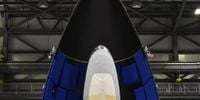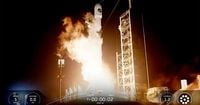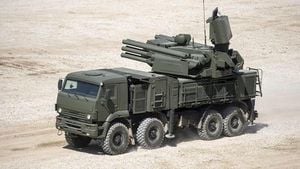On the night of August 21, 2025, the U.S. Space Force marked a milestone in its ongoing quest to secure the high ground of space, launching the secretive X-37B spaceplane for its eighth mission. The reusable, uncrewed craft—built by Boeing and operated in partnership with the Air Force Rapid Capabilities Office—blasted off at 11:50 p.m. EST from the historic Launch Complex 39A at NASA’s Kennedy Space Center in Florida, riding atop a SpaceX Falcon 9 rocket. The mission, designated OTV-8, is shrouded in secrecy, but officials have revealed that it will focus on testing cutting-edge laser communications technology and quantum inertial sensors, both seen as critical for the future of military and scientific operations in orbit.
According to Space Systems Command, the launch went off without a hitch. “The mission, carrying the U.S. Air Force X-37B Orbital Test Vehicle (OTV) spacecraft, lifted off on schedule at 11:50 p.m. EST (8:50 p.m. PST),” the command confirmed in a press release early Friday. Boeing followed up the next morning, stating that the “vehicle is healthy on orbit and proceeding with standard checkout.” Michelle Parker, vice president of Boeing Space Mission Systems, highlighted the collaborative spirit behind the mission: “Our role is to make sure the spaceplane is the most reliable testbed it can be. None of this happens without teamwork. Launch is the starting line for this mission, but the work that follows—the quiet, methodical work on orbit, analysis and eventual return—is where progress is earned.”
The X-37B program, which began in 2010, has already logged more than a decade of operational experience, with seven previous missions under its belt. Each flight has tested novel technologies for the Pentagon and NASA, with durations ranging from 224 days to nearly 909 days in space. The most recent mission, which ended in March 2025 after 434 days aloft, showcased advanced aerobraking maneuvers and explored new orbital regimes, space domain awareness, and the effects of radiation on sensitive equipment. The vehicle’s ability to return to Earth and be repurposed for future missions is a significant advantage, allowing rapid iteration and deployment of new technologies.
While much about the current mission remains classified—including its intended orbit and duration—Space Force and Boeing officials have shed light on two key payloads. First, the X-37B will test high-bandwidth inter-satellite laser communications, designed to enable satellites to transmit data directly to one another or to ground stations at speeds and volumes far exceeding traditional radio-frequency links. As Gen. Chance Saltzman, director of space operations for the U.S. Space Force, put it, these tests “will mark an important step in the U.S. Space Force’s ability to leverage proliferated space networks as part of a diversified and redundant space architecture. In so doing, it will strengthen the resilience, reliability, adaptability and data transport speeds of our satellite communications architecture.”
The experiment is closely tied to the Space Development Agency’s ambitious Proliferated Warfighter Space Architecture (PWSA), a mega-constellation of satellites aimed at providing global, secure, and high-speed communications for military operations. The ability to move vast amounts of data quickly and securely between satellites is seen as a game-changer for both defense and scientific applications—especially as adversaries develop increasingly sophisticated means to disrupt traditional communications.
The second major experiment involves a quantum inertial sensor, described as the highest-performing device of its kind ever flown in space. Unlike conventional navigation systems that rely on signals from GPS satellites, the quantum sensor detects rotation and acceleration of atoms to determine position, allowing for precise navigation even in GPS-denied environments. According to Col. Ramsey Hom, commander of Space Delta 9, “Whether navigating beyond Earth-based orbits in cislunar space or operating in GPS-denied environments, quantum inertial sensing allows for robust navigation capabilities where GPS navigation is not possible. Ultimately, this technology contributes significantly to our thrust within the Fifth Space Operations Squadron and across the Space Force guaranteeing movement and maneuverability even in GPS-denied environments.”
The quantum payload is part of the Defense Innovation Unit’s Transition Quantum Sensing program, which aims to help the Department of Defense rapidly field advanced quantum sensors. The Air Force Research Laboratory and the Defense Innovation Unit have partnered with NASA and the Space Force for these experiments, reflecting a broader push to integrate commercial and defense innovation in space.
Beyond the technical achievements, the mission comes at a time of unprecedented activity for the Space Force. Col. Ryan Hiserote, senior materiel leader for launch execution at Space Systems Command, noted, “We have more missions queued for launch over the next 12 months than in any prior 12-month period in the history of the NSSL program…and we welcome this challenge. Putting innovative capabilities such as these in orbit builds United States strength in the space domain and increases our nation’s overall warfighting capability.” The coming year will also see the launch of the Space Development Agency’s next batch of data transport and missile tracking satellites, known as Tranche One.
The X-37B itself is a marvel of engineering—a compact, uncrewed vehicle clad in black heat shield tiles and white insulation blankets, resembling a miniature space shuttle with stubby delta wings and twin tail fins. Powered by solar cells and batteries, it features a small payload bay that can accommodate a variety of sensors and experiment packages. Its flexibility is further demonstrated by its ability to launch atop multiple rocket types, including SpaceX’s Falcon 9 and Falcon Heavy, as well as United Launch Alliance’s Atlas 5 and Vulcan boosters. After its missions, the X-37B glides to a runway landing at either Vandenberg Space Force Base in California or Kennedy Space Center, using runways originally built for the space shuttle.
Despite its high profile, many aspects of the X-37B’s operations remain tightly guarded secrets. The exact duration of the current mission is classified, and officials have not disclosed when the spaceplane will return to Earth. As reported by The Wall Street Journal, this flexibility and endurance have made the X-37B a favorite tool for military officials eager to rapidly test and deploy new technologies in orbit. The Fifth Operations Squadron at Joint Base Anacostia-Bolling in Washington, D.C., oversees the craft’s operations, working in close coordination with the Air Force and Space Force.
It’s a busy—and competitive—era for space, with the U.S. determined to maintain an edge as rivals invest heavily in their own orbital capabilities. The X-37B’s eighth mission, with its blend of advanced communications and quantum navigation experiments, underscores the Pentagon’s commitment to innovation and resilience in what many now call the ultimate high ground.
As the X-37B quietly circles the Earth, its true impact may not be felt until months or even years from now, when the technologies it tests begin to shape the future of space operations. For now, the world can only watch and wonder what secrets this silent sentinel is uncovering high above our heads.






